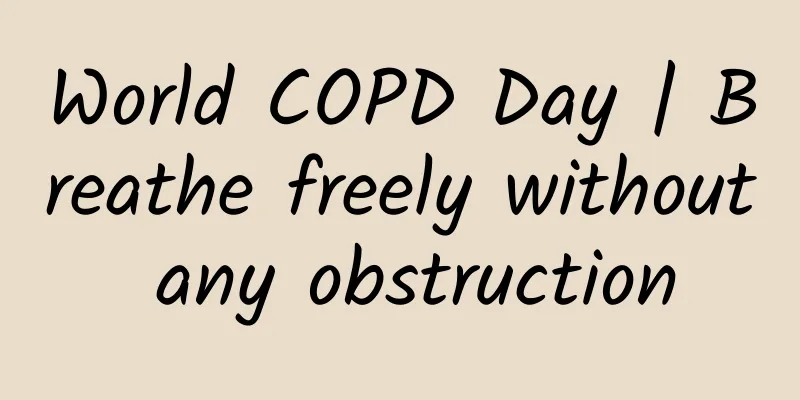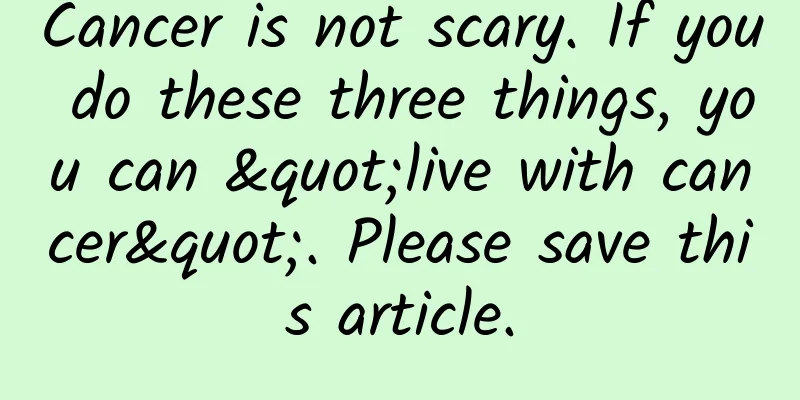World COPD Day | Breathe freely without any obstruction

|
Author: Nie Shan, deputy chief physician of respiratory medicine department, Beijing Friendship Hospital, Capital Medical University Illustration: Nie Shan, deputy chief physician, Department of Respiratory Medicine, Beijing Friendship Hospital, Capital Medical University Reviewer: Xu Bo, Chief Physician and Professor of Respiratory Medicine, Beijing Friendship Hospital, Capital Medical University "Doctor, I have a small wish. I really want to pick up my 2-year-old grandson and show him off in the park." A retired university professor who is nearly 70 years old, successful in his career and happy in his family said this when he came to the hospital for treatment. Such a simple wish is so difficult to achieve. Yes, as a patient with COPD, picking up a child and walking a few steps is often a luxury... November 15, 2023 is the 22nd World COPD Day. Taking this opportunity, let us take a closer look at COPD. 1. What is COPD? Maybe you feel a little strange when you hear this name for the first time, but if you say "chronic bronchitis and emphysema", you will probably feel very familiar with it. In fact, they are all part of the manifestations of COPD. The full name of COPD is chronic obstructive pulmonary disease. As the name suggests, this is a chronic and irreversible airway obstructive lung disease. It is a common, preventable and treatable airway inflammatory disease, and it is also one of the most common respiratory diseases in my country. According to statistics, in my country, the total number of adult COPD patients is close to 100 million, and the incidence of COPD in people over 40 years old is 13.7%, which means that 1 in 8 people will be affected. And with the increase of age, the probability of this disease will show a "blowout" growth. Therefore, the recognition of COPD is really urgent. Figure 1 Copyright image, no permission to reprint 2. What are the clinical manifestations of COPD? Due to chronic and repeated stimulation of airway inflammation, COPD patients will have reactive thickening of the tracheal wall, causing airway stenosis, just like a narrowed lane, when the same amount of traffic passes, a traffic jam will occur. Therefore, dyspnea is the most prominent and typical clinical symptom of COPD, and it is also the most likely cause of anxiety and tension in patients. Just like the university professor we mentioned at the beginning, in the early stage, patients may only experience symptoms when climbing stairs or running. If there is no early intervention, over time, patients may do simple housework at home, or even experience shortness of breath and chest tightness when dressing or lying down to rest. Therefore, if you have frequent coughing and sputum when the seasons change, the amount of sputum increases, and it is not easy to cough it out, and even have dyspnea after activities, then COPD is likely to have targeted you. The "gold standard" for diagnosing COPD is a pulmonary function test. Doctors can use this test to objectively diagnose your "dyspnea" and effectively grade it according to the condition of your lung function to guide the next stage of treatment. If you are already worried about having COPD but are not sure whether you need to do a pulmonary function test, you might as well do a COPD screening self-test first. If you answer "yes" to more than 3 questions, then it is recommended that you go to the respiratory medicine clinic and complete the lung function test as soon as possible. Figure 2 Copyright image, no permission to reprint 3. How to treat COPD? "Since COPD is irreversible and can't be cured anyway, why not just give it up!" Some elderly patients often "challenge" doctors in outpatient clinics. Indeed, due to the irreversible characteristics of airflow limitation in COPD, it is indeed impossible to adjust medications to restore our blood pressure and blood sugar to normal levels like hypertension and diabetes that we are familiar with. Therefore, everyone may lose confidence in treatment and even be unwilling to face the fact that they are already ill. However, everyone must clearly realize that the fundamental purpose of COPD treatment is not only treatment, but more importantly prevention. What we want to treat is to relieve the symptoms of COPD coughing and wheezing, so that they can breathe "freely"; what we want to prevent is the acute exacerbation of COPD, reduce the damage to lung function, delay the progression of the disease, and prevent complications of other organs. Ultimately, our symptoms and condition will be well controlled, so that we don't often wheeze when climbing stairs, don't work hard on activities, and cough less at ordinary times, so as to achieve a "high-quality" life like healthy people. The treatment of COPD is mainly divided into drug intervention and non-drug intervention. Drug intervention is different from the previous practice of taking medicine when you are sick. The treatment of COPD is mainly inhaled drugs. Inhaled drugs can reach the lungs directly through the respiratory tract, and they take effect faster, have better effects, and have fewer systemic adverse reactions. There are many types of inhaled drugs, including bronchodilators, inhaled corticosteroids, and inhalers combined with them. In addition to choosing different drugs according to the severity of the disease, you must also choose a suitable device based on the patient's maximum inspiratory flow rate and hand-mouth coordination. This will be left to a professional doctor to customize your exclusive treatment plan for you. There is another point I have to remind you. Before inhaling the drug, you must cough first. If you have sputum, you need to clear the sputum before inhaling the drug to avoid the effective ingredients of the drug being brought out by the sputum and unable to work. Figure 3 Copyright image, no permission to reprint Non-drug treatment is also an important part of COPD treatment. In addition to changing personal lifestyle, quitting smoking, strengthening personal respiratory protection, home oxygen therapy, and vaccination, pulmonary rehabilitation training is an internationally recognized first-line treatment for COPD. It can effectively improve the dyspnea of COPD patients, improve patients' exercise tolerance and quality of life, and improve the physical and mental health of COPD patients. In order to achieve the best pulmonary rehabilitation training ability, there is a cardiopulmonary exercise test (CPET) in clinical practice, which can effectively help patients evaluate their body endurance and give patients the best exercise plan. At the same time, by detecting the CPET level, the patient's pulmonary rehabilitation ability can be better evaluated, which helps to enhance the patient's confidence and treatment compliance. Figure 4 Copyright image, no permission to reprint Respiratory muscle training can strengthen the respiratory muscles, improve lung function and gas exchange in the lungs, and relieve dyspnea symptoms. Here are two tips for breathing training. (1) Pursed lip breathing: First, inhale slowly through your nose, silently counting 1, 2. Then close your lips until there is only a gap, like whistling, and exhale slowly and gently through your lips, silently counting 1, 2, 3, 4. This alternation can open the narrow airway, increase alveolar ventilation, and improve hypoxia. (2) Abdominal breathing: First choose a comfortable position, place your hands on your abdomen, and try to relax. When exhaling, inhale through your nose, sink your abdomen, and use your hands to apply a little pressure, silently counting 1, 2. When inhaling, exhale through your mouth, and the upper abdomen resists the pressure of your hands and slowly bulges, silently counting 1, 2, 3, 4. To sum it up in ten words, "inhale to inflate your abdomen, and exhale to shrink your abdomen." This can improve breathing efficiency, improve gas distribution, reduce breathing power consumption, and relieve symptoms of shortness of breath. In the initial stage of abdominal breathing exercise, do it twice a day for 10 to 15 minutes each time, and incorporate pursed lip exhalation into the abdominal breathing exercise, and do it anytime and anywhere to eventually form a habitual breathing method. In addition, my country's traditional sports such as Ba Duan Jin, Tai Chi, Liu Zi Jue, and breathing exercises can also achieve the effect of respiratory rehabilitation by adjusting the posture, breathing, and mind. Finally, I would like to share with you a couplet: Only when there is no "obstruction" can you breathe freely. COPD and chronic diseases can be prevented and treated. The symptoms include chronic coughing, coughing up white sputum and difficulty breathing. Lung function, early diagnosis, and inhaled medications are key. Go to the hospital for follow-up visits regularly, exercise smartly, and breathe smoothly to stay healthy. Figure 5 Copyright image, no permission to reprint References [1]Global initiative for chronic obstructive lung disease Global strategy for the diagnosis management and prevention of chronic obstructive pulmonary disease 2023report EBOL. http:// gold copd org 2023-gold-report-2. [2]Wang C Xu J Yang L,et,al. Prevalence and risk factors of chronic obstructive pulmonary disease in China the China Pulmonary Health CPH study A national cross-sectional study[J]. Lancet,2018,391,1706-1717. [3] CHEN Yahong. Screening and tools for chronic obstructive pulmonary disease at the grassroots level[J]. Chinese Journal of General Practitioners, 2019, 18(2): 200-203. [4] Chinese Society of Cardiology, Chinese Society of Rehabilitation Medicine, Cardiopulmonary Prevention and Rehabilitation Committee, Editorial Board of Chinese Journal of Cardiovascular Diseases. Chinese expert consensus on the clinical application of cardiopulmonary exercise testing[J]. Chinese Journal of Cardiovascular Diseases, 2022, 50(10):973-986. [5] Expert consensus writing group on the management of chronic obstructive pulmonary disease with integrated traditional Chinese and Western medicine. Expert consensus on the management of chronic obstructive pulmonary disease with integrated traditional Chinese and Western medicine (2023 edition) [J]. Chinese General Practice, 2023, 26(35): 4359-4371. |
<<: Popular Science Illustrations | Technology Opens Up New Ideas for Diabetes Treatment
>>: Why do sunflowers follow the sun? Scientists discover new mechanism →
Recommend
Pantothenic acid product analysis report
Nowadays, there are more and more users of the tw...
All the free promotion methods and techniques for the Android App Market are here!
The matter began with a platform turnover statist...
4 tips to teach you how to operate WeChat groups and QQ groups!
Few people know the purpose of group operations ,...
How to play with free channels - bringing in 300,000 users in three months
When a new APP product enters the market, how to ...
Belief is priceless! The long-delayed ASUS ROG Claymore RGB mechanical keyboard is still worth buying
God said, "Let there be light," and the...
Guangzhou Distribution Mini Program Mall, how long does it take to produce a distribution mini program?
As of now, the number of mini programs has reache...
The higher the bid for Baidu's bidding promotion, the higher the ranking will be?
The higher the bid of Baidu bidding promotion , t...
The evolution and thinking of Taobao Native R&D model
The origin and development of DX DX was hatched f...
E-commerce promotions are cold, and the Double 12 shopping festival is no longer popular. The main reason may be the decline in consumers' shopping desire
In previous years, on this day, i.e., Double 12, ...
Sixty percent of the Greek letters have been used. Why has Omicron become the highest level of concern variant?
According to the announcement released by the WHO...
B Station Brand Marketing Guide!
In May 2021, Bilibili released its first quarter ...
Aerobics first or resistance first? You may have made a mistake when you love to hang out at the gym...
Compiled by: Gong Zixin Go into the gym, Which di...
Tech Neo Technology Salon 15th Special Report - How CDN Makes the Network Smarter
【51CTO.com original article】 [51CTO original arti...
How to create a CocoaPods in Swift
You may be familiar with some well-known open sou...









